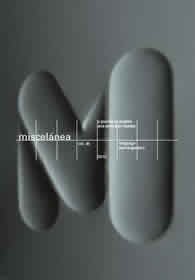Syntactic and Semantic Rules in Old English Adjective Formation
DOI:
https://doi.org/10.26754/ojs_misc/mj.20129259Palabras clave:
funcionamiento morfológico, Modelo de Proceso y Paradigma, Normas sintácticas, Normas semánticas, inglés antiguoResumen
El objetivo de este artículo es ofrecer un análisis paradigmático de la formación de adjetivos mediante afijación en inglés antiguo. Más concretamente, se centra en el cambio de significado atribuible a los procesos de formación de palabras que dan lugar a adjetivos con afijación. En un modelo paradigmático, la modificación formal de los tallos se traduce en modificaciones semánticas y/o sintácticas, que se formulan en términos de reglas semánticas y sintácticas. Tras un análisis de las reglas semánticas y sintácticas que se aplican en la formación de 3.365 adjetivos derivados, se llega a dos conclusiones. En primer lugar, 19 prefijos de un total de 56 realizan una función derivativa, frente a 21 sufijos de un total de 51, lo que significa que el grado de polisemia que presentan los prefijos es ligeramente superior al de los sufijos. En segundo lugar, sólo dos funciones derivativas son realizadas por un afijo, lo que también demuestra que la correspondencia uno a uno entre afijos y funciones derivativas es la excepción y no la regla.
Descargas
Referencias
Beard, Robert and Mark Volpe. 2005. “Lexeme-Morpheme Base Morphology”. In Stekauer, Pavoland Rochelle Lieber (eds.) Handbook of Word-Formation. Dordrecht: Springer: 189- 205.
Bosworth, Joseph and Thomas Northcote Toller.(1898) 1973. An Anglo-Saxon Dictionary and Supplement.Oxford: Clarendon Press.
Brinton, Laurel and Elizabeth Closs Traugott. 2005. Lexicalization and Language Change. Cambridge: Cambridge University Press.
Clark Hall, John R. 1996. A Concise Anglo-Saxon Dictionary and Supplement. Toronto: Toronto University Press.
Cortés Rodríguez, Francisco and Javier Martín Arista. “From directionals to telics: meaning construction, word-formation and grammaticalization in RRG”. In Gómez González, Miguel Ángel, Francisco Gonzálvez García and Francisco Ruiz de Mendoza Ibáñez (eds.) Form and function in language: Functional, cognitive and applied perspectives. Amsterdam: John Benjamins: Forthcoming.
De la Cruz Cabanillas, Isabel. 2007. “Semantic primes in Old English: a preliminary study of descriptors”. SELIM 14: 37-58.
Dik, Simon. (1989) 1997a.The Theory of Functional Grammar. Part 1: The Structure of the Clause. (Ed. by Kees Hengeveld). Berlin: Mouton de Gruyter.
—. 1997b. The Theory of Functional Grammar, Part 2: Complex and Derived Constructions. (Ed. by Kees Hengeveld). Berlin: Mouton de Gruyter.
Ettmüller, Ludwig. (1851)1968. An Analytic Dictionary of English Etymology. Amsterdam: Rodopi.
Guarddon Anelo, María del Carmen. 2009a. “Un análisis de las propiedades combinatorias de los primitivos semánticos a través de las adposiciones complejas en inglés antiguo”. Revista Española de Lingüística 39/2: 93-122.
—. 2009b. “The Natural Semantic Metalanguage of Old English Compound Adpositions”. English Studies30: 61-84.
Healey, Antoinette di Paolo. 2003. The Dictionary of Old English in Electronic Form A-F. Toronto: Dictionary of Old English Project, Centre for Medieval Studies, University of Toronto.
Hengeveld, Kees and Lachlan Mackenzie, J. 2008.Functional Discourse Grammar. A typologically-based theory of language structure. Oxford: Oxford University Press.
Holthausen, Ferdinand. 1963. Altenglischesetymologysches Wörterbuch. Heidelberg: Carl Winter Universitätsverlag.
Kastovsky, Dieter. 1986. “Deverbal nouns in Old and Modern English: from stemformation to word-formation”. In Fisiak, Jacek (ed.) Historical Semantics-Historical Word Formation. Berlin: Mouton de Gruyter: 221-261.
Orel, Vladimir. 2003. A Handbook of Germanic Etymology. Leiden: Brill.
Pounder, Amanda. 2000. Processes and Paradigms in Word-Formation Morphology. Berlin: Mouton de Gruyter.
Sweet, Henry. 1976. The Student’s Dictionary of Anglo-Saxon. Oxford: Clarendon Press.
Torre Alonso, Roberto, Javier Martín Arista, Ana Ibáñez Moreno, Elisa González Torres and Laura Caballero González. 2008. “Fundamentos empíricos y metodológicos de una base de datos léxica de la morfología derivativa del inglés antiguo”. Revista de Lingüística y Lenguas Aplicadas 3: 129-144.
Torre Alonso, Roberto. 2009. Morphological Process Feeding in the Formation of Old English Nouns: Zero Derivation, Affixation and Compounding. PhD Dissertation, Department of Modern Languages, University of La Rioja.
—. 2010. “Morphological process feeding in the formation of Old English nouns”. SKASE Journal of Theoretical Linguistics 7: 57-69.
—. 2011a. “The Morphological Structure of Old English Complex Nouns”. ATLANTIS 33/1: 127-146.
—. 2011b. “Nominal Affix Combinations in Old English: Distribution and Restrictions”. RESLA 24: 257-278.
—. “Recursive suffixation in the formation of Old English nouns”. In Martín Arista, Javier, Roberto Torre Alonso, Andrés Canga Alonso and Inmaculada Medina Barco (eds.) Convergent Approaches on Mediaeval English Language and Literature. Newcastle: Cambridge Scholars: Forthcoming.
Van Valin, Robert. 2005. Exploring the Syntax- Semantics Interface. Cambridge: Cambridge University Press.
—. and Randy Lapolla. 1997. Syntax: Structure, meaning and function. Cambridge: Cambridge University Press.
Descargas
Publicado
Número
Sección
Licencia
Derechos de autor 2013 Raquel Vea Escarza

Esta obra está bajo una licencia internacional Creative Commons Atribución-NoComercial 4.0.


